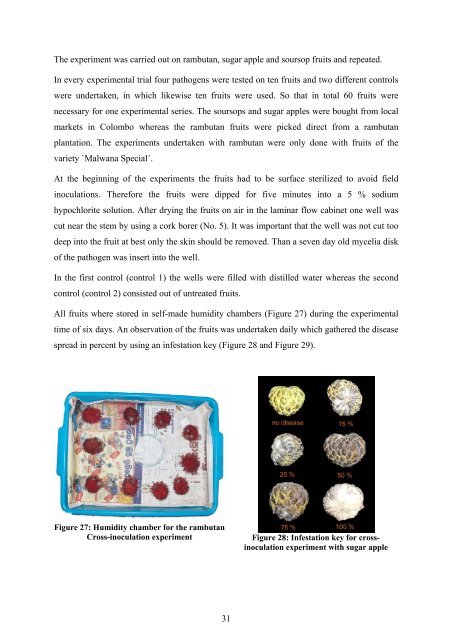Botryodiplodia sp. - Crops for the Future
Botryodiplodia sp. - Crops for the Future
Botryodiplodia sp. - Crops for the Future
You also want an ePaper? Increase the reach of your titles
YUMPU automatically turns print PDFs into web optimized ePapers that Google loves.
The experiment was carried out on rambutan, sugar apple and soursop fruits and repeated.<br />
In every experimental trial four pathogens were tested on ten fruits and two different controls<br />
were undertaken, in which likewise ten fruits were used. So that in total 60 fruits were<br />
necessary <strong>for</strong> one experimental series. The soursops and sugar apples were bought from local<br />
markets in Colombo whereas <strong>the</strong> rambutan fruits were picked direct from a rambutan<br />
plantation. The experiments undertaken with rambutan were only done with fruits of <strong>the</strong><br />
variety `Malwana Special´.<br />
At <strong>the</strong> beginning of <strong>the</strong> experiments <strong>the</strong> fruits had to be surface sterilized to avoid field<br />
inoculations. There<strong>for</strong>e <strong>the</strong> fruits were dipped <strong>for</strong> five minutes into a 5 % sodium<br />
hypochlorite solution. After drying <strong>the</strong> fruits on air in <strong>the</strong> laminar flow cabinet one well was<br />
cut near <strong>the</strong> stem by using a cork borer (No. 5). It was important that <strong>the</strong> well was not cut too<br />
deep into <strong>the</strong> fruit at best only <strong>the</strong> skin should be removed. Than a seven day old mycelia disk<br />
of <strong>the</strong> pathogen was insert into <strong>the</strong> well.<br />
In <strong>the</strong> first control (control 1) <strong>the</strong> wells were filled with distilled water whereas <strong>the</strong> second<br />
control (control 2) consisted out of untreated fruits.<br />
All fruits where stored in self-made humidity chambers (Figure 27) during <strong>the</strong> experimental<br />
time of six days. An observation of <strong>the</strong> fruits was undertaken daily which ga<strong>the</strong>red <strong>the</strong> disease<br />
<strong>sp</strong>read in percent by using an infestation key (Figure 28 and Figure 29).<br />
Figure 27: Humidity chamber <strong>for</strong> <strong>the</strong> rambutan<br />
Cross-inoculation experiment<br />
Figure 28: Infestation key <strong>for</strong> crossinoculation<br />
experiment with sugar apple<br />
31

















